Financial Accounting Report: Technology Ltd Intangible Asset Analysis
VerifiedAdded on 2023/03/20
|8
|2398
|25
Report
AI Summary
This report provides a comprehensive financial accounting analysis of Technology Ltd, a company engaged in technological advancement. The assessment focuses on the accounting treatment of a new asset developed through research and development. It delves into the application of AASB 138, the Australian accounting standard for intangible assets, considering aspects such as asset recognition, valuation, and the treatment of research costs. The report examines the impact of these accounting practices on the company's financial statements, including the reduction of comparability due to different accounting standards. It also explores the importance of understanding AASB 138 for accurate financial reporting and decision-making. The report highlights the importance of the asset's technical feasibility and economic benefits to the company. The report concludes by summarizing the key takeaways and emphasizing the significance of adhering to accounting standards for effective financial reporting.
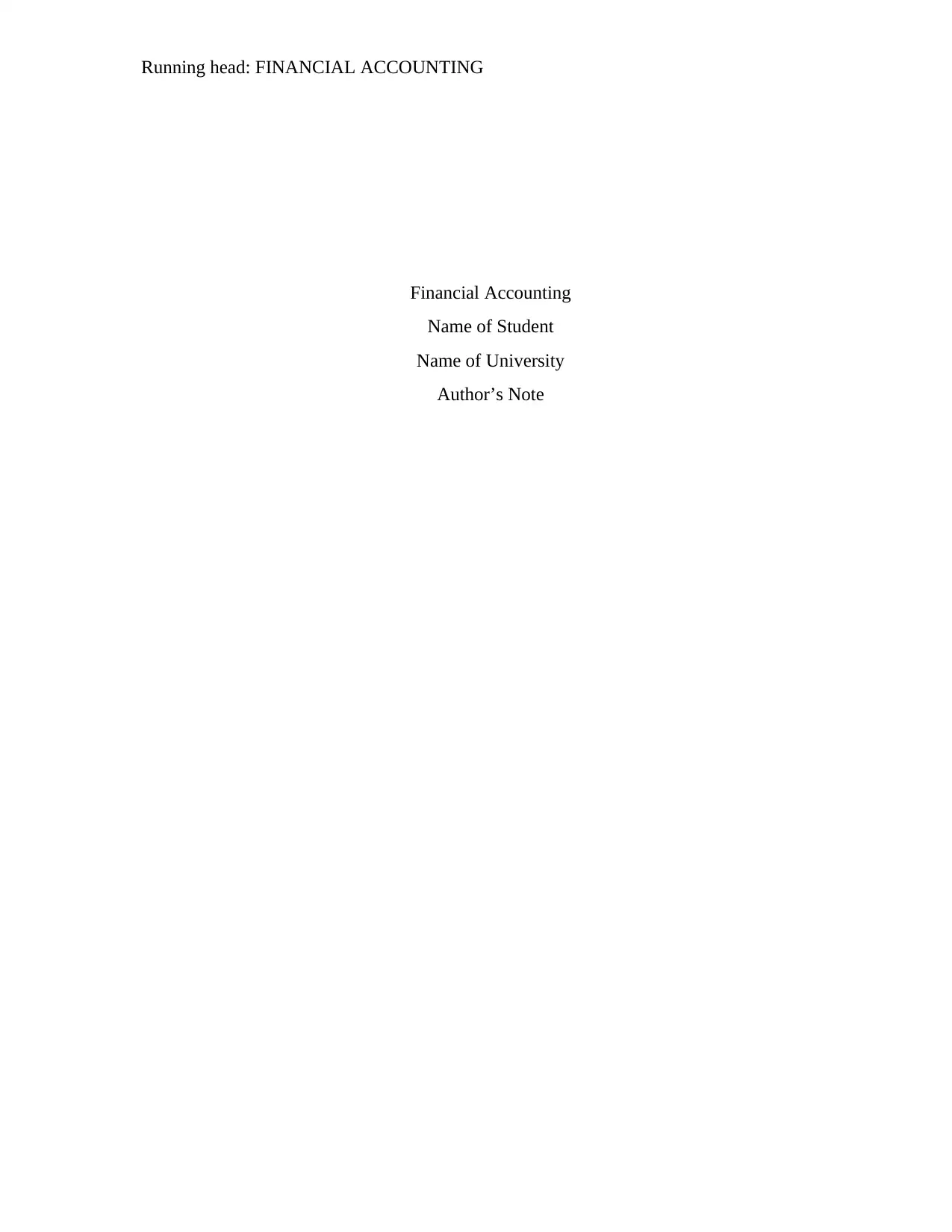
Running head: FINANCIAL ACCOUNTING
Financial Accounting
Name of Student
Name of University
Author’s Note
Financial Accounting
Name of Student
Name of University
Author’s Note
Paraphrase This Document
Need a fresh take? Get an instant paraphrase of this document with our AI Paraphraser
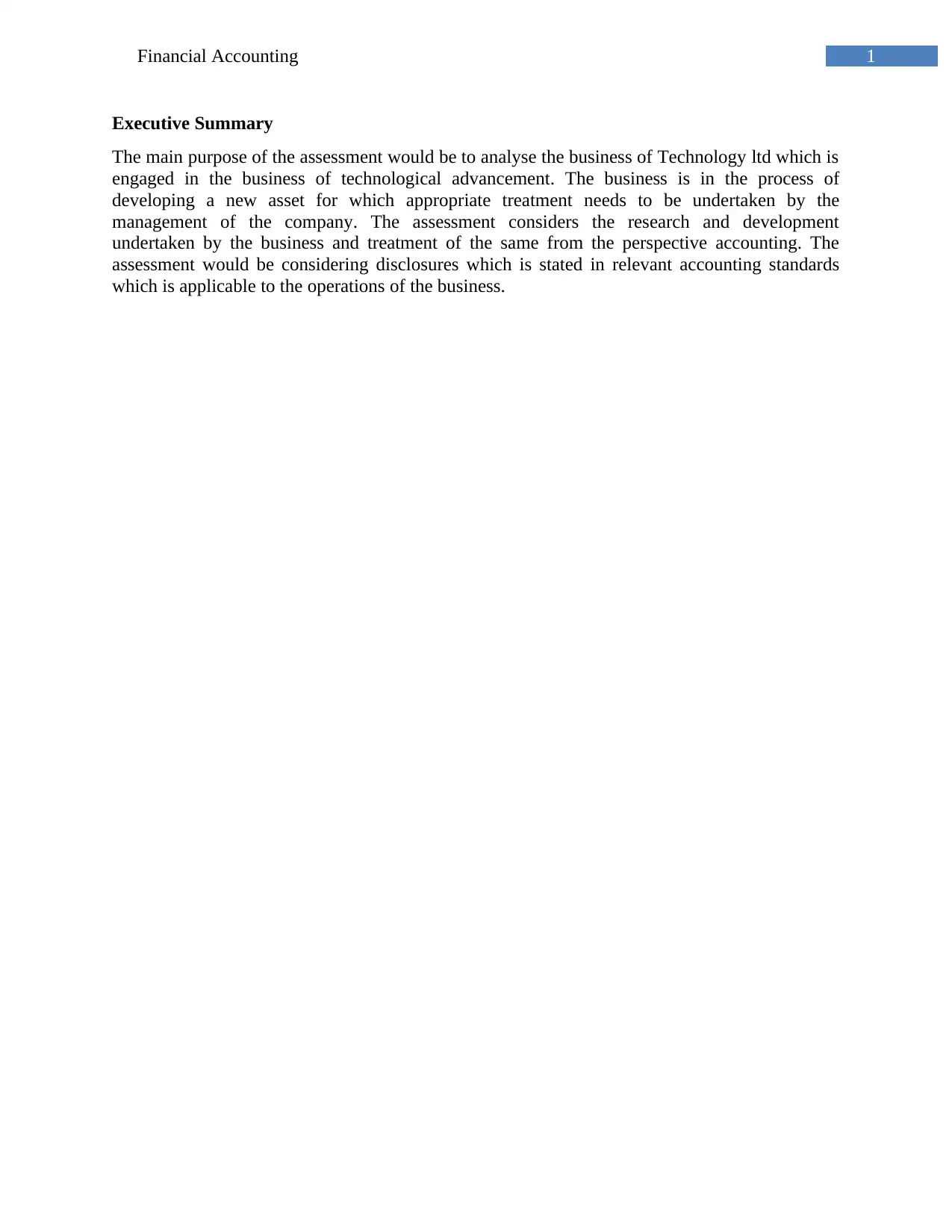
1Financial Accounting
Executive Summary
The main purpose of the assessment would be to analyse the business of Technology ltd which is
engaged in the business of technological advancement. The business is in the process of
developing a new asset for which appropriate treatment needs to be undertaken by the
management of the company. The assessment considers the research and development
undertaken by the business and treatment of the same from the perspective accounting. The
assessment would be considering disclosures which is stated in relevant accounting standards
which is applicable to the operations of the business.
Executive Summary
The main purpose of the assessment would be to analyse the business of Technology ltd which is
engaged in the business of technological advancement. The business is in the process of
developing a new asset for which appropriate treatment needs to be undertaken by the
management of the company. The assessment considers the research and development
undertaken by the business and treatment of the same from the perspective accounting. The
assessment would be considering disclosures which is stated in relevant accounting standards
which is applicable to the operations of the business.
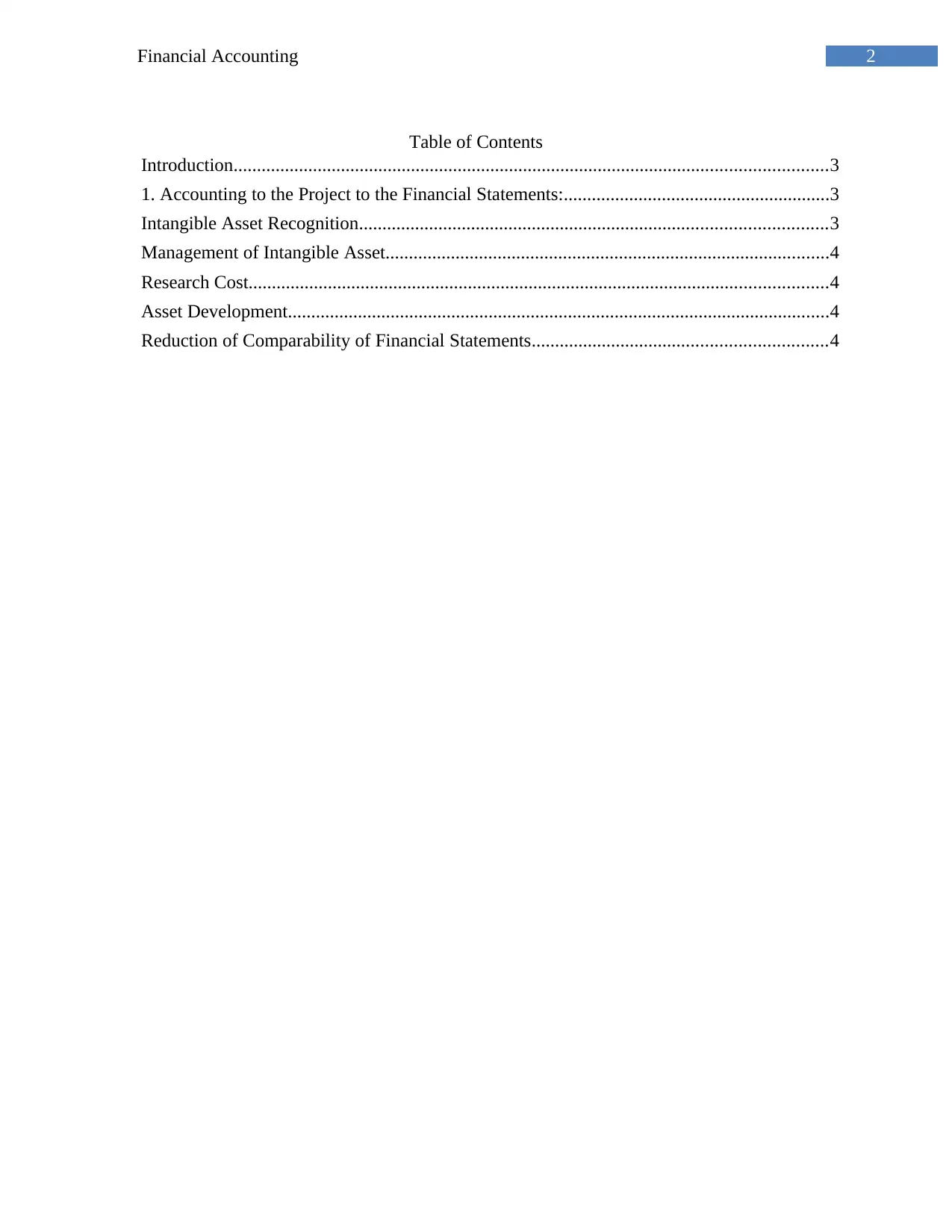
2Financial Accounting
Table of Contents
Introduction...............................................................................................................................3
1. Accounting to the Project to the Financial Statements:.........................................................3
Intangible Asset Recognition....................................................................................................3
Management of Intangible Asset...............................................................................................4
Research Cost............................................................................................................................4
Asset Development....................................................................................................................4
Reduction of Comparability of Financial Statements...............................................................4
Table of Contents
Introduction...............................................................................................................................3
1. Accounting to the Project to the Financial Statements:.........................................................3
Intangible Asset Recognition....................................................................................................3
Management of Intangible Asset...............................................................................................4
Research Cost............................................................................................................................4
Asset Development....................................................................................................................4
Reduction of Comparability of Financial Statements...............................................................4
⊘ This is a preview!⊘
Do you want full access?
Subscribe today to unlock all pages.

Trusted by 1+ million students worldwide
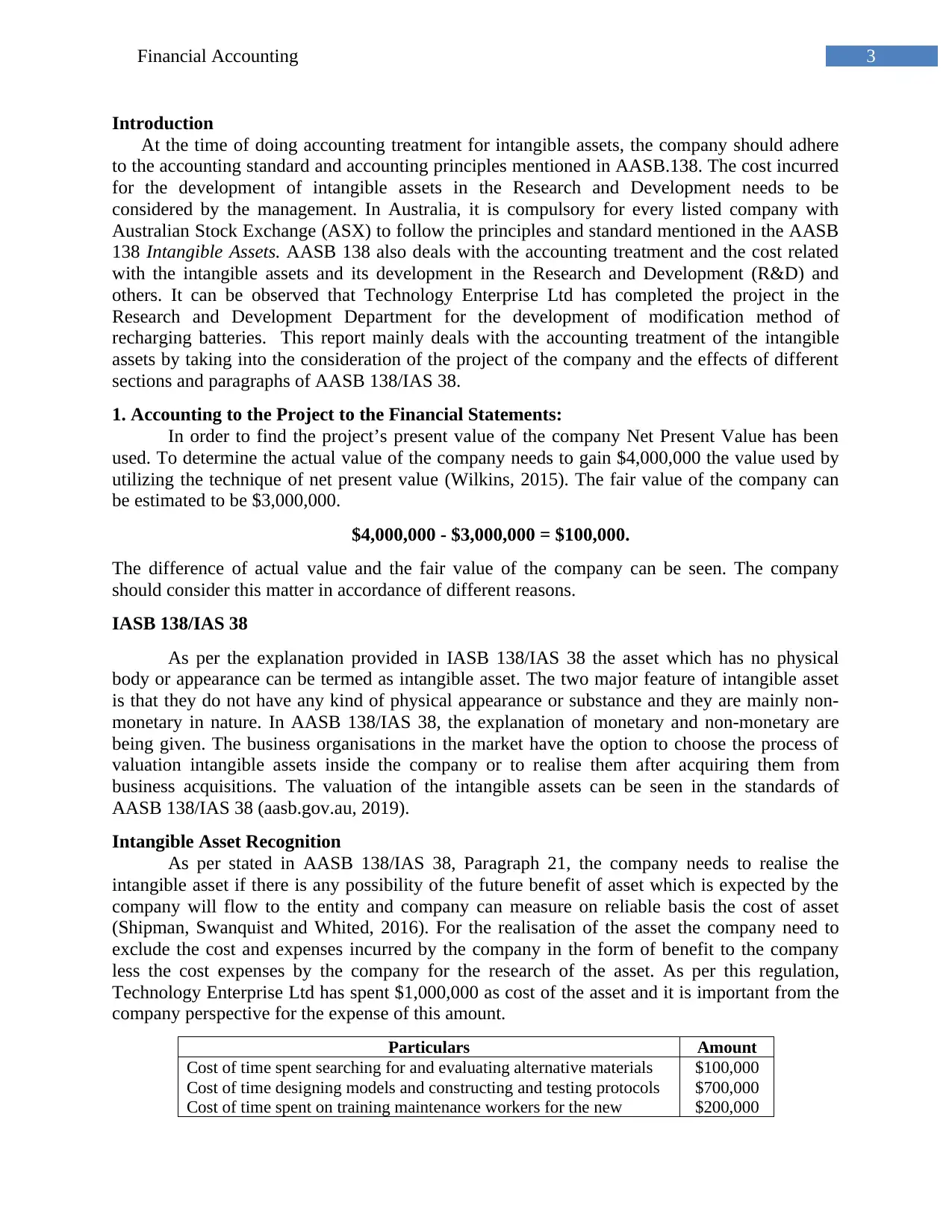
3Financial Accounting
Introduction
At the time of doing accounting treatment for intangible assets, the company should adhere
to the accounting standard and accounting principles mentioned in AASB.138. The cost incurred
for the development of intangible assets in the Research and Development needs to be
considered by the management. In Australia, it is compulsory for every listed company with
Australian Stock Exchange (ASX) to follow the principles and standard mentioned in the AASB
138 Intangible Assets. AASB 138 also deals with the accounting treatment and the cost related
with the intangible assets and its development in the Research and Development (R&D) and
others. It can be observed that Technology Enterprise Ltd has completed the project in the
Research and Development Department for the development of modification method of
recharging batteries. This report mainly deals with the accounting treatment of the intangible
assets by taking into the consideration of the project of the company and the effects of different
sections and paragraphs of AASB 138/IAS 38.
1. Accounting to the Project to the Financial Statements:
In order to find the project’s present value of the company Net Present Value has been
used. To determine the actual value of the company needs to gain $4,000,000 the value used by
utilizing the technique of net present value (Wilkins, 2015). The fair value of the company can
be estimated to be $3,000,000.
$4,000,000 - $3,000,000 = $100,000.
The difference of actual value and the fair value of the company can be seen. The company
should consider this matter in accordance of different reasons.
IASB 138/IAS 38
As per the explanation provided in IASB 138/IAS 38 the asset which has no physical
body or appearance can be termed as intangible asset. The two major feature of intangible asset
is that they do not have any kind of physical appearance or substance and they are mainly non-
monetary in nature. In AASB 138/IAS 38, the explanation of monetary and non-monetary are
being given. The business organisations in the market have the option to choose the process of
valuation intangible assets inside the company or to realise them after acquiring them from
business acquisitions. The valuation of the intangible assets can be seen in the standards of
AASB 138/IAS 38 (aasb.gov.au, 2019).
Intangible Asset Recognition
As per stated in AASB 138/IAS 38, Paragraph 21, the company needs to realise the
intangible asset if there is any possibility of the future benefit of asset which is expected by the
company will flow to the entity and company can measure on reliable basis the cost of asset
(Shipman, Swanquist and Whited, 2016). For the realisation of the asset the company need to
exclude the cost and expenses incurred by the company in the form of benefit to the company
less the cost expenses by the company for the research of the asset. As per this regulation,
Technology Enterprise Ltd has spent $1,000,000 as cost of the asset and it is important from the
company perspective for the expense of this amount.
Particulars Amount
Cost of time spent searching for and evaluating alternative materials
Cost of time designing models and constructing and testing protocols
Cost of time spent on training maintenance workers for the new
$100,000
$700,000
$200,000
Introduction
At the time of doing accounting treatment for intangible assets, the company should adhere
to the accounting standard and accounting principles mentioned in AASB.138. The cost incurred
for the development of intangible assets in the Research and Development needs to be
considered by the management. In Australia, it is compulsory for every listed company with
Australian Stock Exchange (ASX) to follow the principles and standard mentioned in the AASB
138 Intangible Assets. AASB 138 also deals with the accounting treatment and the cost related
with the intangible assets and its development in the Research and Development (R&D) and
others. It can be observed that Technology Enterprise Ltd has completed the project in the
Research and Development Department for the development of modification method of
recharging batteries. This report mainly deals with the accounting treatment of the intangible
assets by taking into the consideration of the project of the company and the effects of different
sections and paragraphs of AASB 138/IAS 38.
1. Accounting to the Project to the Financial Statements:
In order to find the project’s present value of the company Net Present Value has been
used. To determine the actual value of the company needs to gain $4,000,000 the value used by
utilizing the technique of net present value (Wilkins, 2015). The fair value of the company can
be estimated to be $3,000,000.
$4,000,000 - $3,000,000 = $100,000.
The difference of actual value and the fair value of the company can be seen. The company
should consider this matter in accordance of different reasons.
IASB 138/IAS 38
As per the explanation provided in IASB 138/IAS 38 the asset which has no physical
body or appearance can be termed as intangible asset. The two major feature of intangible asset
is that they do not have any kind of physical appearance or substance and they are mainly non-
monetary in nature. In AASB 138/IAS 38, the explanation of monetary and non-monetary are
being given. The business organisations in the market have the option to choose the process of
valuation intangible assets inside the company or to realise them after acquiring them from
business acquisitions. The valuation of the intangible assets can be seen in the standards of
AASB 138/IAS 38 (aasb.gov.au, 2019).
Intangible Asset Recognition
As per stated in AASB 138/IAS 38, Paragraph 21, the company needs to realise the
intangible asset if there is any possibility of the future benefit of asset which is expected by the
company will flow to the entity and company can measure on reliable basis the cost of asset
(Shipman, Swanquist and Whited, 2016). For the realisation of the asset the company need to
exclude the cost and expenses incurred by the company in the form of benefit to the company
less the cost expenses by the company for the research of the asset. As per this regulation,
Technology Enterprise Ltd has spent $1,000,000 as cost of the asset and it is important from the
company perspective for the expense of this amount.
Particulars Amount
Cost of time spent searching for and evaluating alternative materials
Cost of time designing models and constructing and testing protocols
Cost of time spent on training maintenance workers for the new
$100,000
$700,000
$200,000
Paraphrase This Document
Need a fresh take? Get an instant paraphrase of this document with our AI Paraphraser
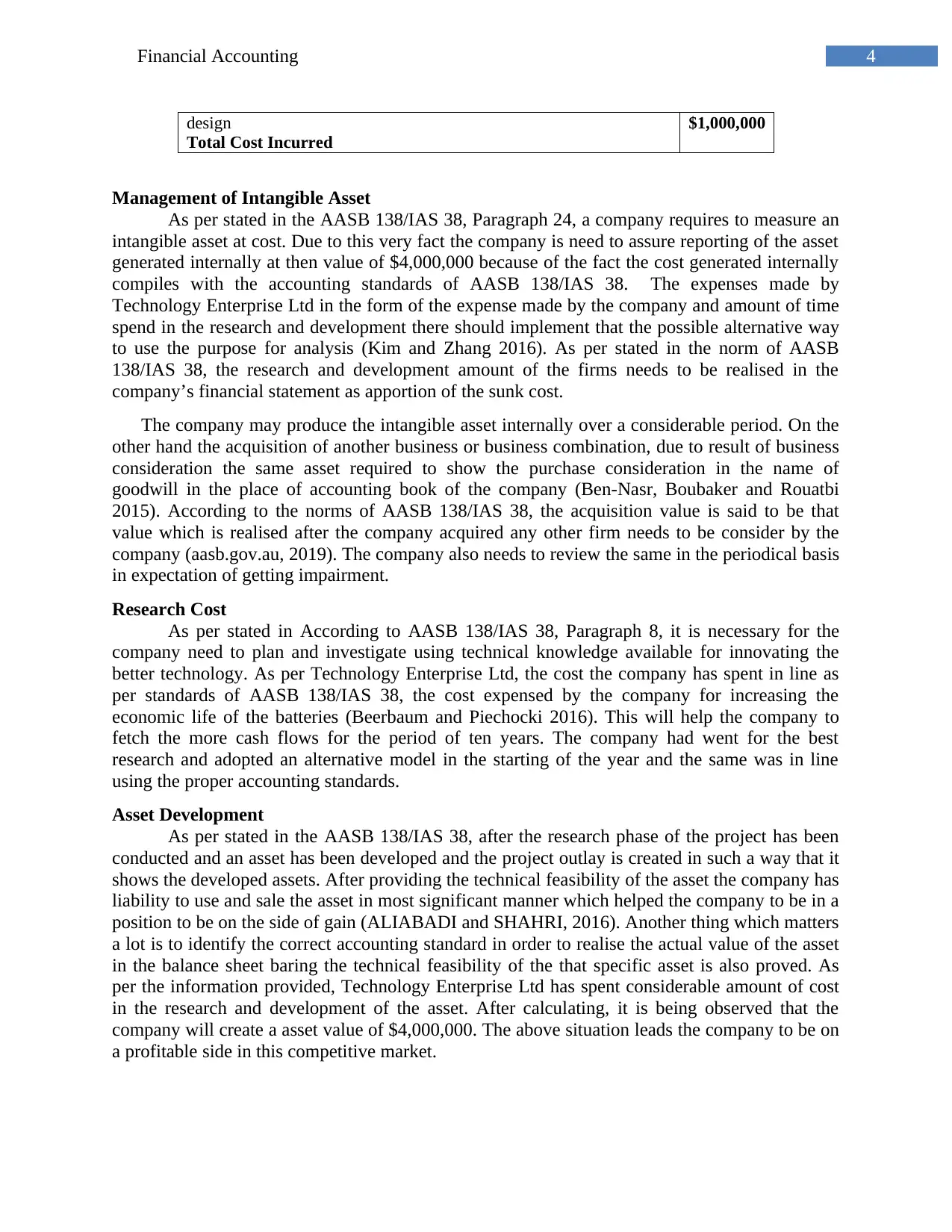
4Financial Accounting
design
Total Cost Incurred
$1,000,000
Management of Intangible Asset
As per stated in the AASB 138/IAS 38, Paragraph 24, a company requires to measure an
intangible asset at cost. Due to this very fact the company is need to assure reporting of the asset
generated internally at then value of $4,000,000 because of the fact the cost generated internally
compiles with the accounting standards of AASB 138/IAS 38. The expenses made by
Technology Enterprise Ltd in the form of the expense made by the company and amount of time
spend in the research and development there should implement that the possible alternative way
to use the purpose for analysis (Kim and Zhang 2016). As per stated in the norm of AASB
138/IAS 38, the research and development amount of the firms needs to be realised in the
company’s financial statement as apportion of the sunk cost.
The company may produce the intangible asset internally over a considerable period. On the
other hand the acquisition of another business or business combination, due to result of business
consideration the same asset required to show the purchase consideration in the name of
goodwill in the place of accounting book of the company (Ben-Nasr, Boubaker and Rouatbi
2015). According to the norms of AASB 138/IAS 38, the acquisition value is said to be that
value which is realised after the company acquired any other firm needs to be consider by the
company (aasb.gov.au, 2019). The company also needs to review the same in the periodical basis
in expectation of getting impairment.
Research Cost
As per stated in According to AASB 138/IAS 38, Paragraph 8, it is necessary for the
company need to plan and investigate using technical knowledge available for innovating the
better technology. As per Technology Enterprise Ltd, the cost the company has spent in line as
per standards of AASB 138/IAS 38, the cost expensed by the company for increasing the
economic life of the batteries (Beerbaum and Piechocki 2016). This will help the company to
fetch the more cash flows for the period of ten years. The company had went for the best
research and adopted an alternative model in the starting of the year and the same was in line
using the proper accounting standards.
Asset Development
As per stated in the AASB 138/IAS 38, after the research phase of the project has been
conducted and an asset has been developed and the project outlay is created in such a way that it
shows the developed assets. After providing the technical feasibility of the asset the company has
liability to use and sale the asset in most significant manner which helped the company to be in a
position to be on the side of gain (ALIABADI and SHAHRI, 2016). Another thing which matters
a lot is to identify the correct accounting standard in order to realise the actual value of the asset
in the balance sheet baring the technical feasibility of the that specific asset is also proved. As
per the information provided, Technology Enterprise Ltd has spent considerable amount of cost
in the research and development of the asset. After calculating, it is being observed that the
company will create a asset value of $4,000,000. The above situation leads the company to be on
a profitable side in this competitive market.
design
Total Cost Incurred
$1,000,000
Management of Intangible Asset
As per stated in the AASB 138/IAS 38, Paragraph 24, a company requires to measure an
intangible asset at cost. Due to this very fact the company is need to assure reporting of the asset
generated internally at then value of $4,000,000 because of the fact the cost generated internally
compiles with the accounting standards of AASB 138/IAS 38. The expenses made by
Technology Enterprise Ltd in the form of the expense made by the company and amount of time
spend in the research and development there should implement that the possible alternative way
to use the purpose for analysis (Kim and Zhang 2016). As per stated in the norm of AASB
138/IAS 38, the research and development amount of the firms needs to be realised in the
company’s financial statement as apportion of the sunk cost.
The company may produce the intangible asset internally over a considerable period. On the
other hand the acquisition of another business or business combination, due to result of business
consideration the same asset required to show the purchase consideration in the name of
goodwill in the place of accounting book of the company (Ben-Nasr, Boubaker and Rouatbi
2015). According to the norms of AASB 138/IAS 38, the acquisition value is said to be that
value which is realised after the company acquired any other firm needs to be consider by the
company (aasb.gov.au, 2019). The company also needs to review the same in the periodical basis
in expectation of getting impairment.
Research Cost
As per stated in According to AASB 138/IAS 38, Paragraph 8, it is necessary for the
company need to plan and investigate using technical knowledge available for innovating the
better technology. As per Technology Enterprise Ltd, the cost the company has spent in line as
per standards of AASB 138/IAS 38, the cost expensed by the company for increasing the
economic life of the batteries (Beerbaum and Piechocki 2016). This will help the company to
fetch the more cash flows for the period of ten years. The company had went for the best
research and adopted an alternative model in the starting of the year and the same was in line
using the proper accounting standards.
Asset Development
As per stated in the AASB 138/IAS 38, after the research phase of the project has been
conducted and an asset has been developed and the project outlay is created in such a way that it
shows the developed assets. After providing the technical feasibility of the asset the company has
liability to use and sale the asset in most significant manner which helped the company to be in a
position to be on the side of gain (ALIABADI and SHAHRI, 2016). Another thing which matters
a lot is to identify the correct accounting standard in order to realise the actual value of the asset
in the balance sheet baring the technical feasibility of the that specific asset is also proved. As
per the information provided, Technology Enterprise Ltd has spent considerable amount of cost
in the research and development of the asset. After calculating, it is being observed that the
company will create a asset value of $4,000,000. The above situation leads the company to be on
a profitable side in this competitive market.
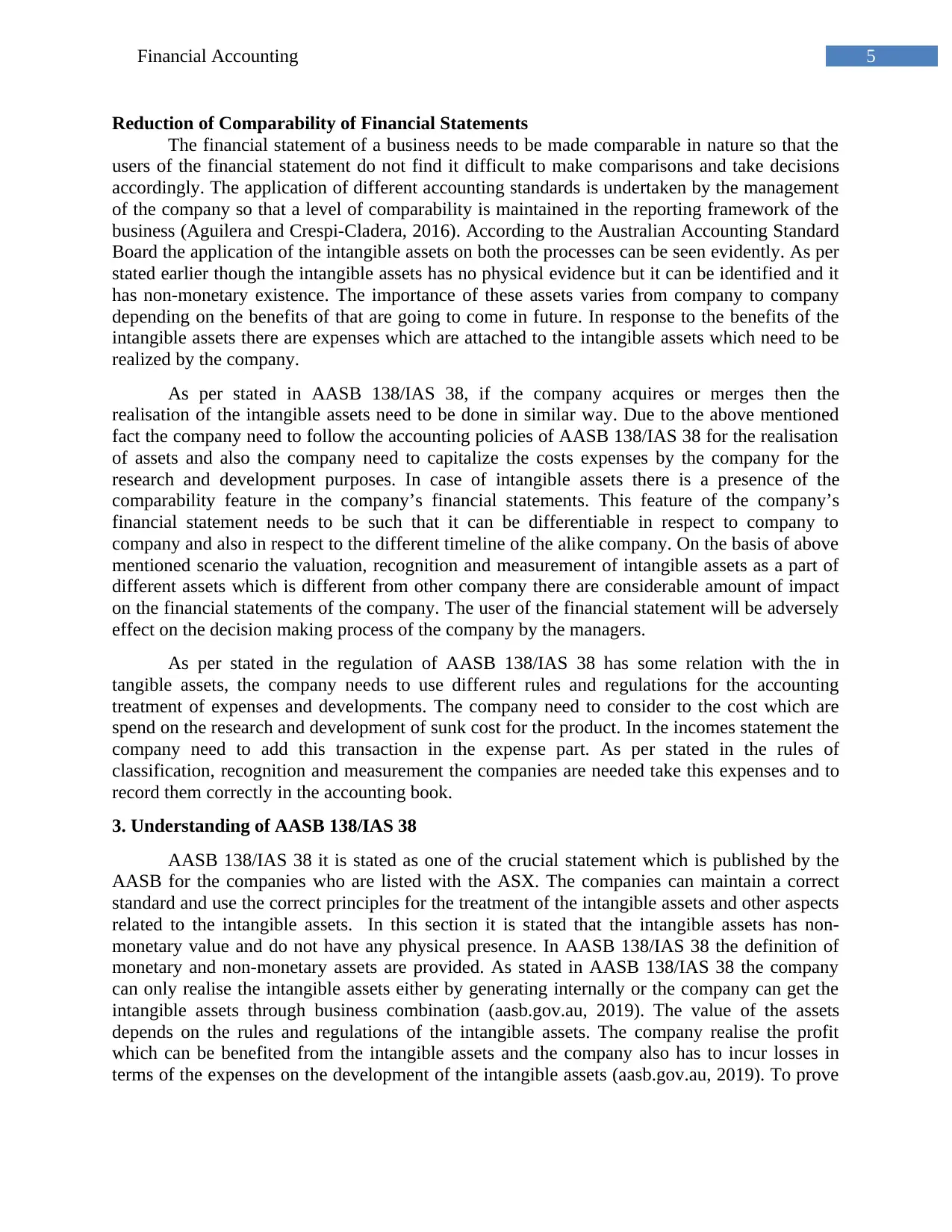
5Financial Accounting
Reduction of Comparability of Financial Statements
The financial statement of a business needs to be made comparable in nature so that the
users of the financial statement do not find it difficult to make comparisons and take decisions
accordingly. The application of different accounting standards is undertaken by the management
of the company so that a level of comparability is maintained in the reporting framework of the
business (Aguilera and Crespi-Cladera, 2016). According to the Australian Accounting Standard
Board the application of the intangible assets on both the processes can be seen evidently. As per
stated earlier though the intangible assets has no physical evidence but it can be identified and it
has non-monetary existence. The importance of these assets varies from company to company
depending on the benefits of that are going to come in future. In response to the benefits of the
intangible assets there are expenses which are attached to the intangible assets which need to be
realized by the company.
As per stated in AASB 138/IAS 38, if the company acquires or merges then the
realisation of the intangible assets need to be done in similar way. Due to the above mentioned
fact the company need to follow the accounting policies of AASB 138/IAS 38 for the realisation
of assets and also the company need to capitalize the costs expenses by the company for the
research and development purposes. In case of intangible assets there is a presence of the
comparability feature in the company’s financial statements. This feature of the company’s
financial statement needs to be such that it can be differentiable in respect to company to
company and also in respect to the different timeline of the alike company. On the basis of above
mentioned scenario the valuation, recognition and measurement of intangible assets as a part of
different assets which is different from other company there are considerable amount of impact
on the financial statements of the company. The user of the financial statement will be adversely
effect on the decision making process of the company by the managers.
As per stated in the regulation of AASB 138/IAS 38 has some relation with the in
tangible assets, the company needs to use different rules and regulations for the accounting
treatment of expenses and developments. The company need to consider to the cost which are
spend on the research and development of sunk cost for the product. In the incomes statement the
company need to add this transaction in the expense part. As per stated in the rules of
classification, recognition and measurement the companies are needed take this expenses and to
record them correctly in the accounting book.
3. Understanding of AASB 138/IAS 38
AASB 138/IAS 38 it is stated as one of the crucial statement which is published by the
AASB for the companies who are listed with the ASX. The companies can maintain a correct
standard and use the correct principles for the treatment of the intangible assets and other aspects
related to the intangible assets. In this section it is stated that the intangible assets has non-
monetary value and do not have any physical presence. In AASB 138/IAS 38 the definition of
monetary and non-monetary assets are provided. As stated in AASB 138/IAS 38 the company
can only realise the intangible assets either by generating internally or the company can get the
intangible assets through business combination (aasb.gov.au, 2019). The value of the assets
depends on the rules and regulations of the intangible assets. The company realise the profit
which can be benefited from the intangible assets and the company also has to incur losses in
terms of the expenses on the development of the intangible assets (aasb.gov.au, 2019). To prove
Reduction of Comparability of Financial Statements
The financial statement of a business needs to be made comparable in nature so that the
users of the financial statement do not find it difficult to make comparisons and take decisions
accordingly. The application of different accounting standards is undertaken by the management
of the company so that a level of comparability is maintained in the reporting framework of the
business (Aguilera and Crespi-Cladera, 2016). According to the Australian Accounting Standard
Board the application of the intangible assets on both the processes can be seen evidently. As per
stated earlier though the intangible assets has no physical evidence but it can be identified and it
has non-monetary existence. The importance of these assets varies from company to company
depending on the benefits of that are going to come in future. In response to the benefits of the
intangible assets there are expenses which are attached to the intangible assets which need to be
realized by the company.
As per stated in AASB 138/IAS 38, if the company acquires or merges then the
realisation of the intangible assets need to be done in similar way. Due to the above mentioned
fact the company need to follow the accounting policies of AASB 138/IAS 38 for the realisation
of assets and also the company need to capitalize the costs expenses by the company for the
research and development purposes. In case of intangible assets there is a presence of the
comparability feature in the company’s financial statements. This feature of the company’s
financial statement needs to be such that it can be differentiable in respect to company to
company and also in respect to the different timeline of the alike company. On the basis of above
mentioned scenario the valuation, recognition and measurement of intangible assets as a part of
different assets which is different from other company there are considerable amount of impact
on the financial statements of the company. The user of the financial statement will be adversely
effect on the decision making process of the company by the managers.
As per stated in the regulation of AASB 138/IAS 38 has some relation with the in
tangible assets, the company needs to use different rules and regulations for the accounting
treatment of expenses and developments. The company need to consider to the cost which are
spend on the research and development of sunk cost for the product. In the incomes statement the
company need to add this transaction in the expense part. As per stated in the rules of
classification, recognition and measurement the companies are needed take this expenses and to
record them correctly in the accounting book.
3. Understanding of AASB 138/IAS 38
AASB 138/IAS 38 it is stated as one of the crucial statement which is published by the
AASB for the companies who are listed with the ASX. The companies can maintain a correct
standard and use the correct principles for the treatment of the intangible assets and other aspects
related to the intangible assets. In this section it is stated that the intangible assets has non-
monetary value and do not have any physical presence. In AASB 138/IAS 38 the definition of
monetary and non-monetary assets are provided. As stated in AASB 138/IAS 38 the company
can only realise the intangible assets either by generating internally or the company can get the
intangible assets through business combination (aasb.gov.au, 2019). The value of the assets
depends on the rules and regulations of the intangible assets. The company realise the profit
which can be benefited from the intangible assets and the company also has to incur losses in
terms of the expenses on the development of the intangible assets (aasb.gov.au, 2019). To prove
⊘ This is a preview!⊘
Do you want full access?
Subscribe today to unlock all pages.

Trusted by 1+ million students worldwide
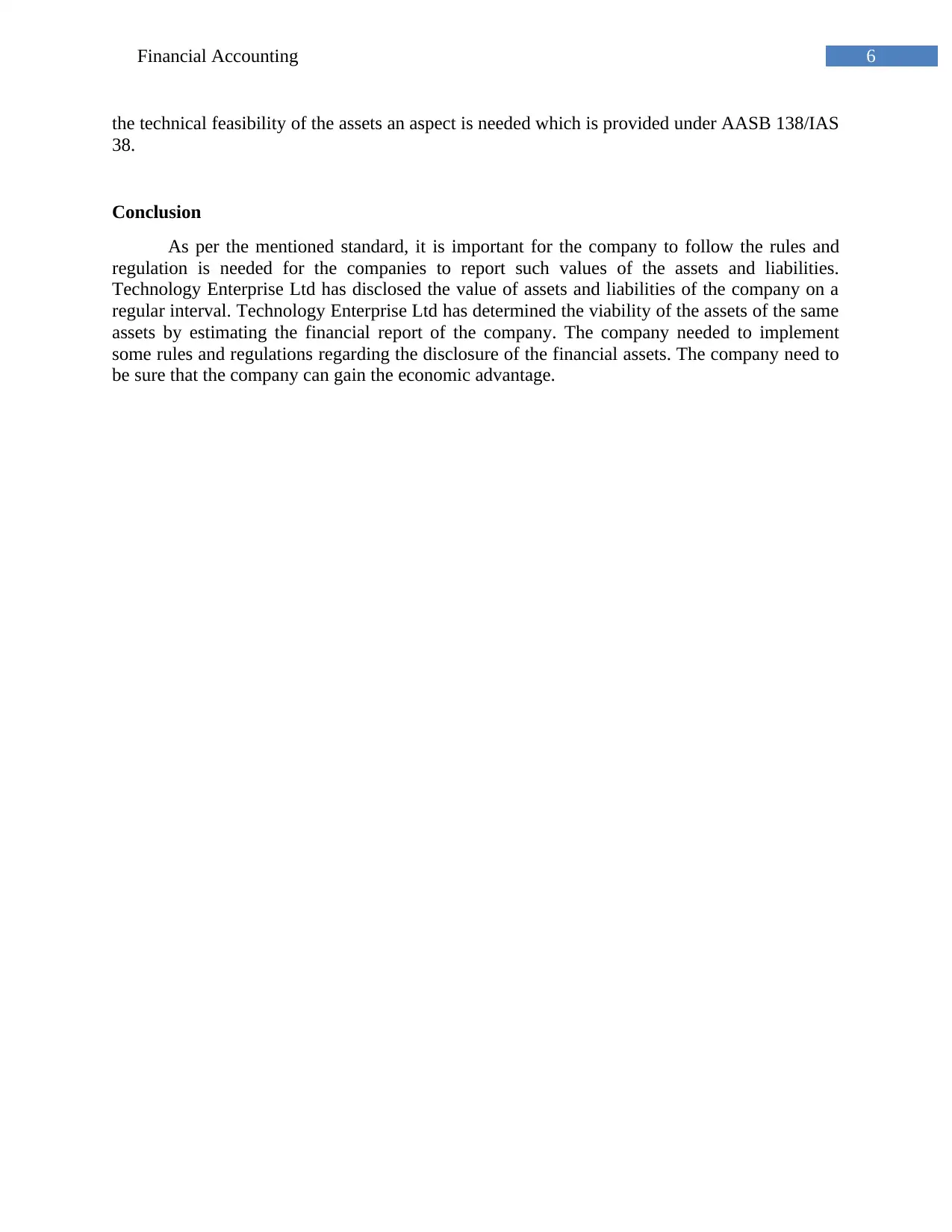
6Financial Accounting
the technical feasibility of the assets an aspect is needed which is provided under AASB 138/IAS
38.
Conclusion
As per the mentioned standard, it is important for the company to follow the rules and
regulation is needed for the companies to report such values of the assets and liabilities.
Technology Enterprise Ltd has disclosed the value of assets and liabilities of the company on a
regular interval. Technology Enterprise Ltd has determined the viability of the assets of the same
assets by estimating the financial report of the company. The company needed to implement
some rules and regulations regarding the disclosure of the financial assets. The company need to
be sure that the company can gain the economic advantage.
the technical feasibility of the assets an aspect is needed which is provided under AASB 138/IAS
38.
Conclusion
As per the mentioned standard, it is important for the company to follow the rules and
regulation is needed for the companies to report such values of the assets and liabilities.
Technology Enterprise Ltd has disclosed the value of assets and liabilities of the company on a
regular interval. Technology Enterprise Ltd has determined the viability of the assets of the same
assets by estimating the financial report of the company. The company needed to implement
some rules and regulations regarding the disclosure of the financial assets. The company need to
be sure that the company can gain the economic advantage.
Paraphrase This Document
Need a fresh take? Get an instant paraphrase of this document with our AI Paraphraser
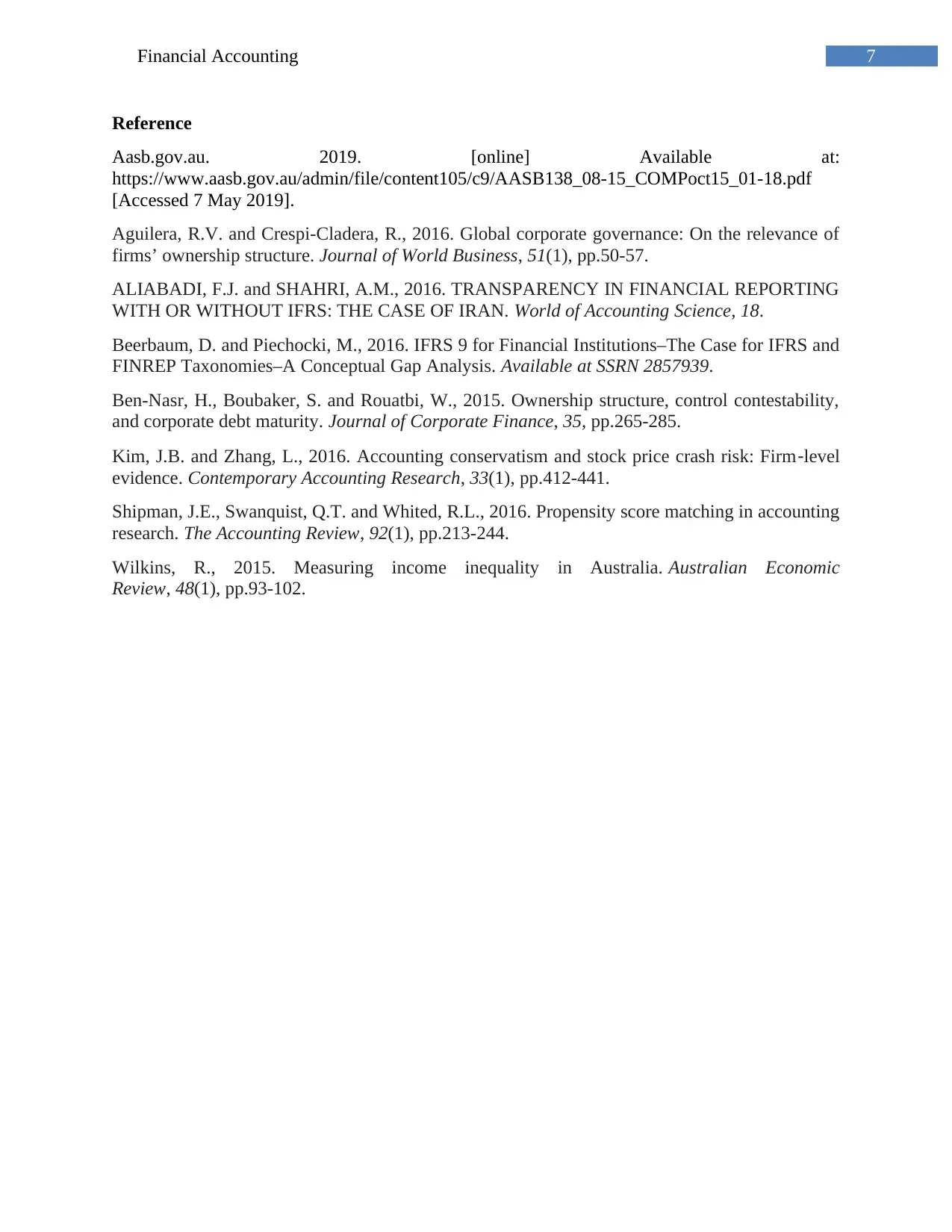
7Financial Accounting
Reference
Aasb.gov.au. 2019. [online] Available at:
https://www.aasb.gov.au/admin/file/content105/c9/AASB138_08-15_COMPoct15_01-18.pdf
[Accessed 7 May 2019].
Aguilera, R.V. and Crespi-Cladera, R., 2016. Global corporate governance: On the relevance of
firms’ ownership structure. Journal of World Business, 51(1), pp.50-57.
ALIABADI, F.J. and SHAHRI, A.M., 2016. TRANSPARENCY IN FINANCIAL REPORTING
WITH OR WITHOUT IFRS: THE CASE OF IRAN. World of Accounting Science, 18.
Beerbaum, D. and Piechocki, M., 2016. IFRS 9 for Financial Institutions–The Case for IFRS and
FINREP Taxonomies–A Conceptual Gap Analysis. Available at SSRN 2857939.
Ben-Nasr, H., Boubaker, S. and Rouatbi, W., 2015. Ownership structure, control contestability,
and corporate debt maturity. Journal of Corporate Finance, 35, pp.265-285.
Kim, J.B. and Zhang, L., 2016. Accounting conservatism and stock price crash risk: Firm‐level
evidence. Contemporary Accounting Research, 33(1), pp.412-441.
Shipman, J.E., Swanquist, Q.T. and Whited, R.L., 2016. Propensity score matching in accounting
research. The Accounting Review, 92(1), pp.213-244.
Wilkins, R., 2015. Measuring income inequality in Australia. Australian Economic
Review, 48(1), pp.93-102.
Reference
Aasb.gov.au. 2019. [online] Available at:
https://www.aasb.gov.au/admin/file/content105/c9/AASB138_08-15_COMPoct15_01-18.pdf
[Accessed 7 May 2019].
Aguilera, R.V. and Crespi-Cladera, R., 2016. Global corporate governance: On the relevance of
firms’ ownership structure. Journal of World Business, 51(1), pp.50-57.
ALIABADI, F.J. and SHAHRI, A.M., 2016. TRANSPARENCY IN FINANCIAL REPORTING
WITH OR WITHOUT IFRS: THE CASE OF IRAN. World of Accounting Science, 18.
Beerbaum, D. and Piechocki, M., 2016. IFRS 9 for Financial Institutions–The Case for IFRS and
FINREP Taxonomies–A Conceptual Gap Analysis. Available at SSRN 2857939.
Ben-Nasr, H., Boubaker, S. and Rouatbi, W., 2015. Ownership structure, control contestability,
and corporate debt maturity. Journal of Corporate Finance, 35, pp.265-285.
Kim, J.B. and Zhang, L., 2016. Accounting conservatism and stock price crash risk: Firm‐level
evidence. Contemporary Accounting Research, 33(1), pp.412-441.
Shipman, J.E., Swanquist, Q.T. and Whited, R.L., 2016. Propensity score matching in accounting
research. The Accounting Review, 92(1), pp.213-244.
Wilkins, R., 2015. Measuring income inequality in Australia. Australian Economic
Review, 48(1), pp.93-102.
1 out of 8
Related Documents
Your All-in-One AI-Powered Toolkit for Academic Success.
+13062052269
info@desklib.com
Available 24*7 on WhatsApp / Email
![[object Object]](/_next/static/media/star-bottom.7253800d.svg)
Unlock your academic potential
Copyright © 2020–2025 A2Z Services. All Rights Reserved. Developed and managed by ZUCOL.





